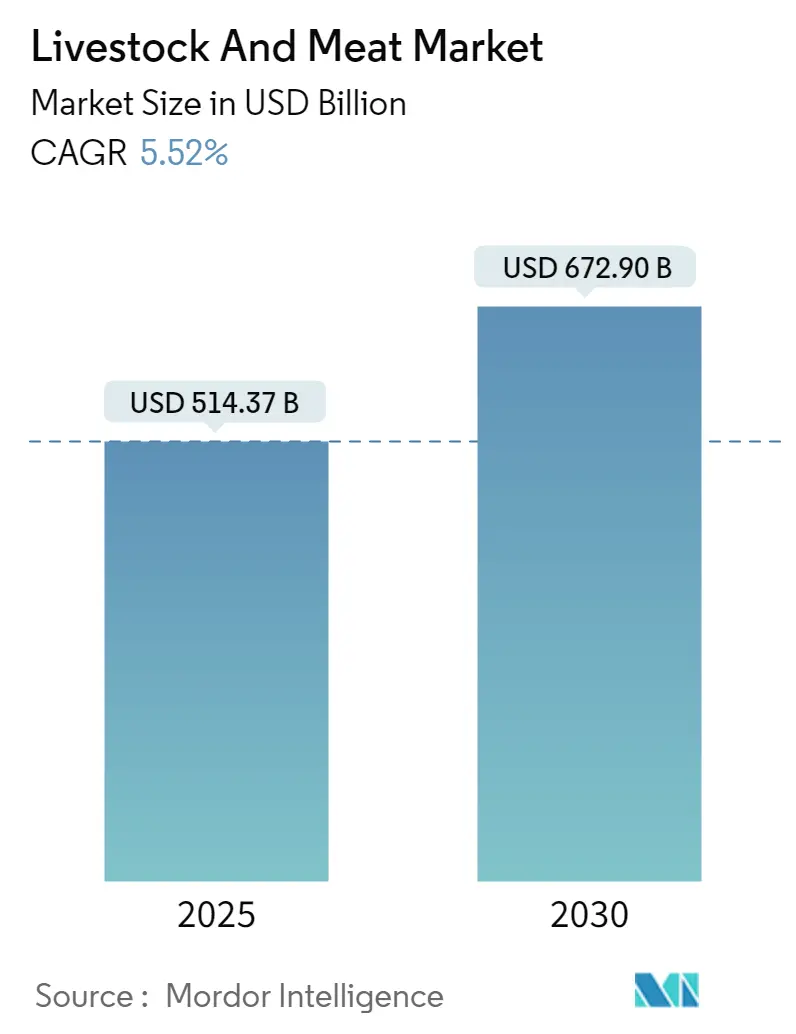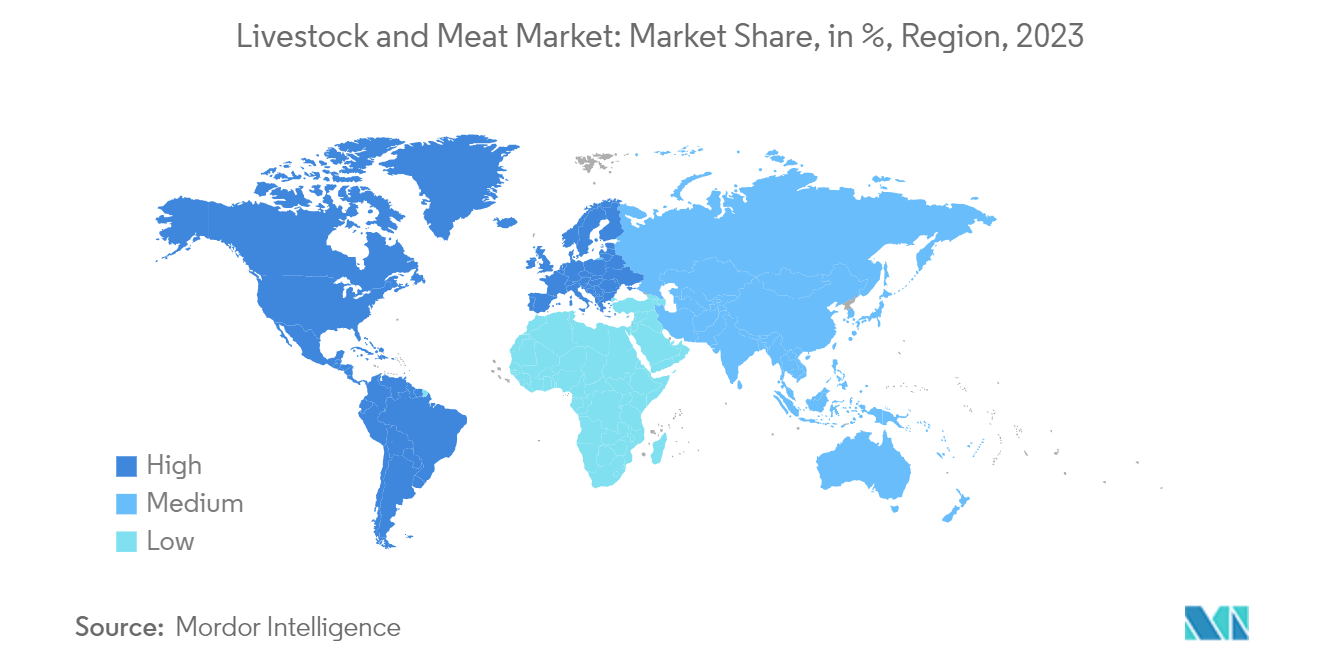
Livestock And Meat Market Analysis
The Livestock And Meat Market size is estimated at USD 514.37 billion in 2025, and is expected to reach USD 672.90 billion by 2030, at a CAGR of 5.52% during the forecast period (2025-2030).
Meat is produced majorly in countries like China, the United States, Brazil, India, Russia, Germany, Mexico, Spain, Argentina, and France. The increasing consumption demand stems from higher disposable income, a growing preference for protein-rich food, and supportive government initiatives across various countries. According to the U.S. Bureau of Economic Analysis, the disposable personal income in the United States increased from USD 19.2 thousand in 2022 to USD 21.9 thousand in 2024, showing a 14% growth. This increase has enhanced the meat purchasing power of U.S. consumers.
The global expansion of fast-food chains, restaurants, and ready-to-eat meal options continues to drive meat consumption. Developing countries like India are witnessing significant restaurant growth, both locally and internationally. For example, Curefoods launched its first Sharief Bhai outlet in Dubai in 2023, marking its international expansion. Furthermore, European countries' meat imports are increasing due to their cold climate conditions. According to the ITC Trade Map, Italy's beef import volume reached 322,173 metric tons in 2023, up from 311,148 metric tons in the previous year. These factors indicate continued market growth during the forecast period.
Livestock And Meat Market Trends
Increasing Demand for Edible Meat
Meat consumption encompasses the human consumption of beef, veal, pig, poultry, and sheep. Regions with cold climates, including the European Union, Russia, and North America, demonstrate higher edible meat consumption patterns. This increased consumption is attributed to meat's ability to provide energy and sustenance during winter months. The consumption levels are influenced by factors such as living standards, livestock production capacity, and consumer prices, while production is characterized by high costs and elevated output prices. According to the Organization for Economic Cooperation and Development (OECD), Argentina led global beef and veal consumption in 2023 with 30.8 kg retail weight per capita, followed by Israel at 25.8 kg and the United States at 25.2 kg retail weight.
The high nutritional density of meat compared to plant-based foods drives consumption patterns. According to the Beef Cattle Research Council, beef provides complete protein and essential nutrients like iron, zinc, and vitamin B12, which are crucial throughout life stages and less abundant in plant-based alternatives. Moreover, the rising global demand for edible meat has led to increased meat imports worldwide. The United States recorded beef imports of 629,080 metric tons in 2023, representing a 2.5% increase from the previous year, as reported by the ITC Trade Map. International trade agreements continue to facilitate meat consumption across borders. A notable example is the 2023 Free Trade Agreement between Australia and the United Kingdom, which eliminated import tariffs on Australian sheep meat entering the UK market.

Asia-Pacific is the Fastest Growing Market
The Asia-Pacific region's expanding meat production is driving significant growth in the global livestock and meat industry, with China maintaining its position as the world's largest meat producer, followed by the United States, the European Union, Brazil, and Russia. According to FAOSTAT, China's pork production reached 55.4 million metric tons in 2022, representing 45.2% of global pork production. As the industry evolves, the global livestock sector continues to strengthen through increasing consolidation and integration of production units, particularly in developing markets.
Rapid urbanization and population growth in Asia-Pacific countries, particularly China, India, and Indonesia, have increased the demand for meat products, with China emerging as a dominant force in the global meat trade. With a population exceeding 1.4 billion, China is the world's largest meat importer, with imports valued at USD 26.7 million, accounting for 16.5% of global meat import value, according to ITC Trade Map. India has established itself as the eighth-largest meat producer globally, with the poultry sector dominating domestic production. According to the Basic Animal Husbandry Statistics - 2024, India's meat production composition includes poultry at 48.96%, buffalo meat at 18.09%, sheep and goat at 11.13%, and cattle at 2.60%.

Livestock And Meat Market News
- December 2024: China removed its final ban on two Australian beef exporters, concluding a series of restrictions and sanctions on Australian products valued at USD 20 billion. This removal of trade barriers is going to increase meat trade between the two countries.
- July 2024: The U.S. Department of Agriculture (USDA) is investing USD 110 million through two programs: the Meat and Poultry Processing Expansion Program (MPPEP) and the Local Meat Capacity (Local MCap) Grant Program. As part of this investment, through a partnership with the New Hampshire Community Loan Fund, the USDA is providing USD 83 million in grants to 24 independent processors across 15 states.
Livestock And Meat Industry Segmentation
Meat comprises the edible portions of animals, primarily from domesticated cattle, swine, and sheep. These portions include muscles, fat, tendons, and ligaments. The meat market is segmented into two main categories based on livestock activity and geography. The Global Livestock & Meat Market is Segmented by Livestock Activity (Live Animals Trade, Edible Meat, Meat Byproducts, and Livestock Products) and Geography (North America, Europe, Asia-Pacific, South America, and Middle-East and Africa). The Report Offers Market Size and Forecast for the Livestock and Meat Market in Value (USD) and Volume (metric Tons) for all the Above Segments.
| Livestock Activity | Live Animals Trade | ||
| Edible Meat | Beef | ||
| Poultry | |||
| Pork | |||
| Mutton | |||
| Other Edible Meat | |||
| Meat Byproducts | Meat Offal | ||
| Fats | |||
| Livestock Products | Raw Milk | ||
| Eggs | |||
| Natural Honey | |||
| Beeswax | |||
| Wool | |||
| Raw Hides and Skin | |||
| Geography | North America | United States | |
| Canada | |||
| Mexico | |||
| Rest of North America | |||
| Europe | Germany | ||
| United Kingdom | |||
| France | |||
| Spain | |||
| Russia | |||
| Italy | |||
| Rest of Europe | |||
| Asia-Pacific | China | ||
| India | |||
| Australia | |||
| Japan | |||
| Rest of Asia-Pacific | |||
| South America | Brazil | ||
| Argentina | |||
| Rest of South America | |||
| Middle-East and Africa | Saudi Arabia | ||
| South Africa | |||
| Rest of Middle-East and Africa | |||
Livestock And Meat Market Research FAQs
How big is the Livestock And Meat Market?
The Livestock And Meat Market size is expected to reach USD 514.37 billion in 2025 and grow at a CAGR of 5.52% to reach USD 672.90 billion by 2030.
What is the current Livestock And Meat Market size?
In 2025, the Livestock And Meat Market size is expected to reach USD 514.37 billion.
Which is the fastest growing region in Livestock And Meat Market?
Asia-Pacific is estimated to grow at the highest CAGR over the forecast period (2025-2030).
Which region has the biggest share in Livestock And Meat Market?
In 2025, the North America accounts for the largest market share in Livestock And Meat Market.
What years does this Livestock And Meat Market cover, and what was the market size in 2024?
In 2024, the Livestock And Meat Market size was estimated at USD 485.98 billion. The report covers the Livestock And Meat Market historical market size for years: 2019, 2020, 2021, 2022, 2023 and 2024. The report also forecasts the Livestock And Meat Market size for years: 2025, 2026, 2027, 2028, 2029 and 2030.
Our Best Selling Reports
Livestock And Meat Industry Report
Statistics for the 2025 Livestock And Meat market share, size and revenue growth rate, created by Mordor Intelligence™ Industry Reports. Livestock And Meat analysis includes a market forecast outlook for 2025 to 2030 and historical overview. Get a sample of this industry analysis as a free report PDF download.


